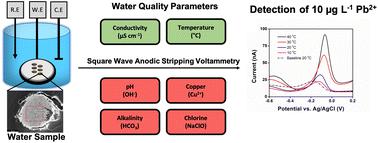Our official English website, www.x-mol.net, welcomes your
feedback! (Note: you will need to create a separate account there.)
Impact of physical and chemical parameters on square wave anodic stripping voltammetry for trace Pb2+ detection in water
Analyst ( IF 3.6 ) Pub Date : 2022-06-30 , DOI: 10.1039/d2an00724j Connor E Rahm 1 , Pankaj Gupta 1 , Vandna K Gupta 1 , Artur Huseinov 1 , Ben Griesmer 1 , Noe T Alvarez 1
Analyst ( IF 3.6 ) Pub Date : 2022-06-30 , DOI: 10.1039/d2an00724j Connor E Rahm 1 , Pankaj Gupta 1 , Vandna K Gupta 1 , Artur Huseinov 1 , Ben Griesmer 1 , Noe T Alvarez 1
Affiliation

|
Exposure to lead, a toxic heavy metal, in drinking water is a worldwide problem. Lead leaching from lead service lines, the main contamination source, and other plumbing materials is controlled by the plumbosolvency of water. Square wave anodic stripping voltammetry (SWASV) has been greatly explored as a rapid and portable technique for the detection of trace Pb2+ ions in drinking water. However, the impact of water quality parameters (WQP) on the SWASV technique is not well understood. Herein, SWASV was employed to detect 10 μg L−1 Pb2+ and determine trends in the stripping peak changes in simulated water samples while individually varying the pH, conductivity, alkalinity, free chlorine, temperature, and copper levels. The pH and conductivity were controlled using the buffer 3-(N-morpholino)propanesulfonic acid (MOPS), and NaNO3, respectively and kept at pH = 7.0 and conductivity = 500 μS cm−1 when exploring other WQPs. The working electrode, a gold-nanoparticle-modified carbon nanotube fiber cross-section (AuNP-CNTf-CS) electrode provided sufficiently sharp and prominent peaks for 10 μg L−1 Pb2+ detection as well as good reproducibility, with a relative error of 5.9% in simulated water. We found that conductivity, and temperature had a proportional relationship to the peak height, and pH, alkalinity, free chlorine, and copper had an inverse relationship. In addition, increasing the copper concentration caused broadening and shifting of the Pb2+ stripping peak. At extremely low conductivities (<100 μS cm−1), the voltammograms became difficult to interpret owing to the formation of inverted and distorted peaks. These trends were then also observed within a local drinking water sample in order to validate the results.
中文翻译:

理化参数对方波阳极溶出伏安法检测水中痕量Pb2+的影响
饮用水中的铅是一种有毒重金属,是一个世界性的问题。铅管道、主要污染源和其他管道材料中的铅浸出受水的铅溶解能力控制。方波阳极溶出伏安法 (SWASV) 作为一种快速、便携的检测饮用水中痕量 Pb 2+离子的技术,得到了广泛的探索。然而,水质参数 (WQP) 对 SWASV 技术的影响尚不清楚。在此,采用 SWASV 检测 10 μg L -1 Pb 2+并确定模拟水样中溶出峰变化的趋势,同时单独改变 pH、电导率、碱度、游离氯、温度和铜含量。在探索其他 WQP 时,分别使用缓冲液 3-( N-吗啉代)丙磺酸 (MOPS) 和 NaNO 3控制 pH 值和电导率,并保持在 pH = 7.0 和电导率 = 500 μS cm -1 。工作电极,金纳米粒子改性的碳纳米管纤维横截面 (AuNP-CNT f -CS) 电极为 10 μg L -1 Pb 2+提供了足够尖锐和突出的峰检测以及良好的重现性,在模拟水中的相对误差为 5.9%。我们发现电导率和温度与峰高成正比关系,而 pH 值、碱度、游离氯和铜则成反比关系。此外,增加铜浓度导致Pb 2+溶出峰变宽和偏移。在极低的电导率(<100 μS cm -1)下,由于形成倒置和扭曲的峰,伏安图变得难以解释。然后还在当地饮用水样本中观察到这些趋势,以验证结果。
更新日期:2022-06-30
中文翻译:

理化参数对方波阳极溶出伏安法检测水中痕量Pb2+的影响
饮用水中的铅是一种有毒重金属,是一个世界性的问题。铅管道、主要污染源和其他管道材料中的铅浸出受水的铅溶解能力控制。方波阳极溶出伏安法 (SWASV) 作为一种快速、便携的检测饮用水中痕量 Pb 2+离子的技术,得到了广泛的探索。然而,水质参数 (WQP) 对 SWASV 技术的影响尚不清楚。在此,采用 SWASV 检测 10 μg L -1 Pb 2+并确定模拟水样中溶出峰变化的趋势,同时单独改变 pH、电导率、碱度、游离氯、温度和铜含量。在探索其他 WQP 时,分别使用缓冲液 3-( N-吗啉代)丙磺酸 (MOPS) 和 NaNO 3控制 pH 值和电导率,并保持在 pH = 7.0 和电导率 = 500 μS cm -1 。工作电极,金纳米粒子改性的碳纳米管纤维横截面 (AuNP-CNT f -CS) 电极为 10 μg L -1 Pb 2+提供了足够尖锐和突出的峰检测以及良好的重现性,在模拟水中的相对误差为 5.9%。我们发现电导率和温度与峰高成正比关系,而 pH 值、碱度、游离氯和铜则成反比关系。此外,增加铜浓度导致Pb 2+溶出峰变宽和偏移。在极低的电导率(<100 μS cm -1)下,由于形成倒置和扭曲的峰,伏安图变得难以解释。然后还在当地饮用水样本中观察到这些趋势,以验证结果。











































 京公网安备 11010802027423号
京公网安备 11010802027423号